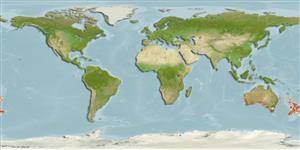Classification / Names
Common names from other countries
Main reference
Size / Weight / Age
Max length : 110 cm SL male/unsexed; (Ref. 6181); max. published weight: 16.0 kg (Ref. 28838); max. reported age: 16 years (Ref. 28786)
Length at first maturity
Lm ?, range 60 - 70 cm
Environment
Marine; benthopelagic; oceanodromous (Ref. 51243); depth range 100 - 800 m (Ref. 6181), usually 300 - 450 m (Ref. 28786)
Climate / Range
Deep-water, preferred 17°C (Ref. 107945); 25°S - 48°S, 109°E - 173°W (Ref. 6181)
Distribution
Southwest Pacific: off southern, southwestern and southeastern Australia, Tasmania and New Zealand. Occurrence records from Madagascar and Japan need to be verified.
Countries | FAO areas | Ecosystems | Occurrences | Introductions
Short description
Dorsal
spines
(total): 18 - 19;
Dorsal
soft rays
(total): 16-19;
Anal
spines: 2;
Anal
soft rays: 13 - 16;
Vertebrae: 36. Body entirely scaled at over 25 cm SL. Lateral line branching below the 5th to the 6th spine of the first dorsal fin. The upper branch reaches beyond the origin of the second dorsal fin, usually ending between the 8th to the 12th soft ray. The lower branch runs mid laterally, undulating above the anal-fin base. Body is bluish above, silvery below, a black blotch distally on two anterior membranes of the first dorsal fin, the rest of the fin is grayish.
IUCN Red List Status (Ref. 115185)
Threat to humans
Harmless
Human uses
Fisheries: commercial
Tools
Special reports
Download XML
Internet sources
Estimates of some properties based on models
Phylogenetic diversity index
PD50 = 0.5078 many relatives (e.g. carps) 0.5 - 2.0 few relatives (e.g. lungfishes)
Trophic Level
4.3 ±0.66 se; Based on food items.
Resilience
Low, minimum population doubling time 4.5 - 14 years (K=0.15-0.21; tm=3-6; tmax=16; Fec=500,000)
Vulnerability
High vulnerability (62 of 100)
Price category
